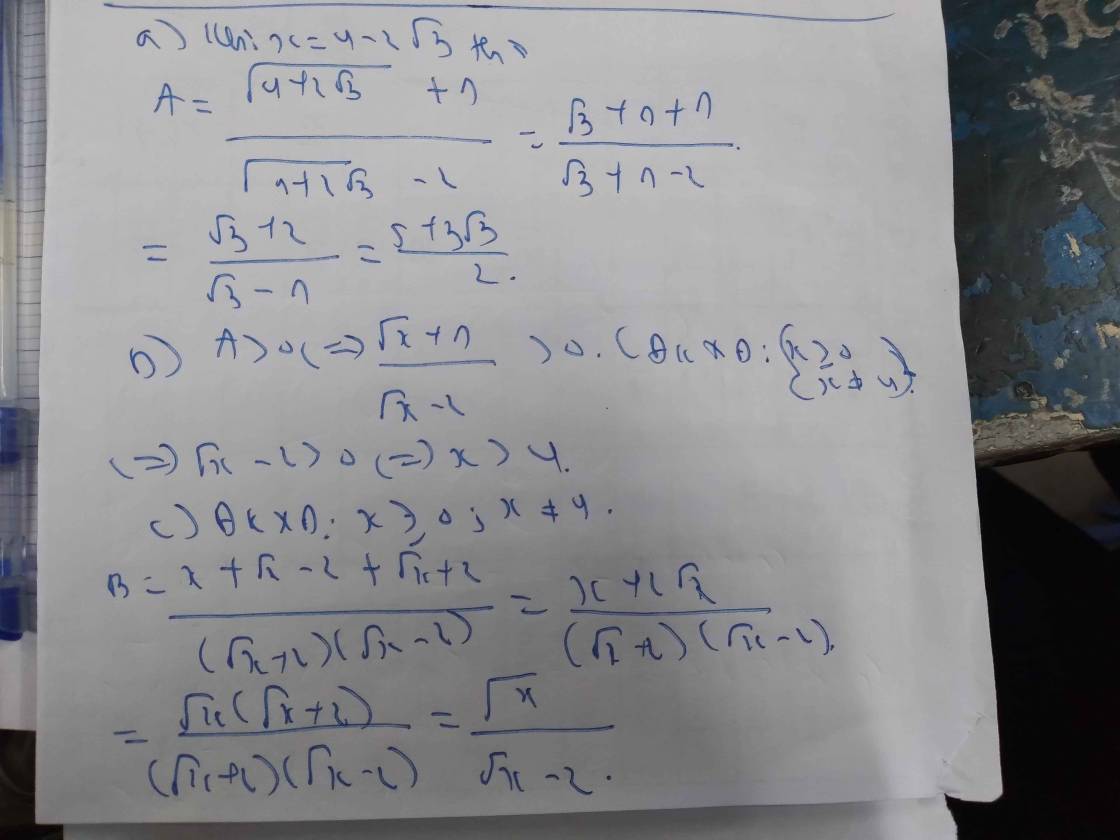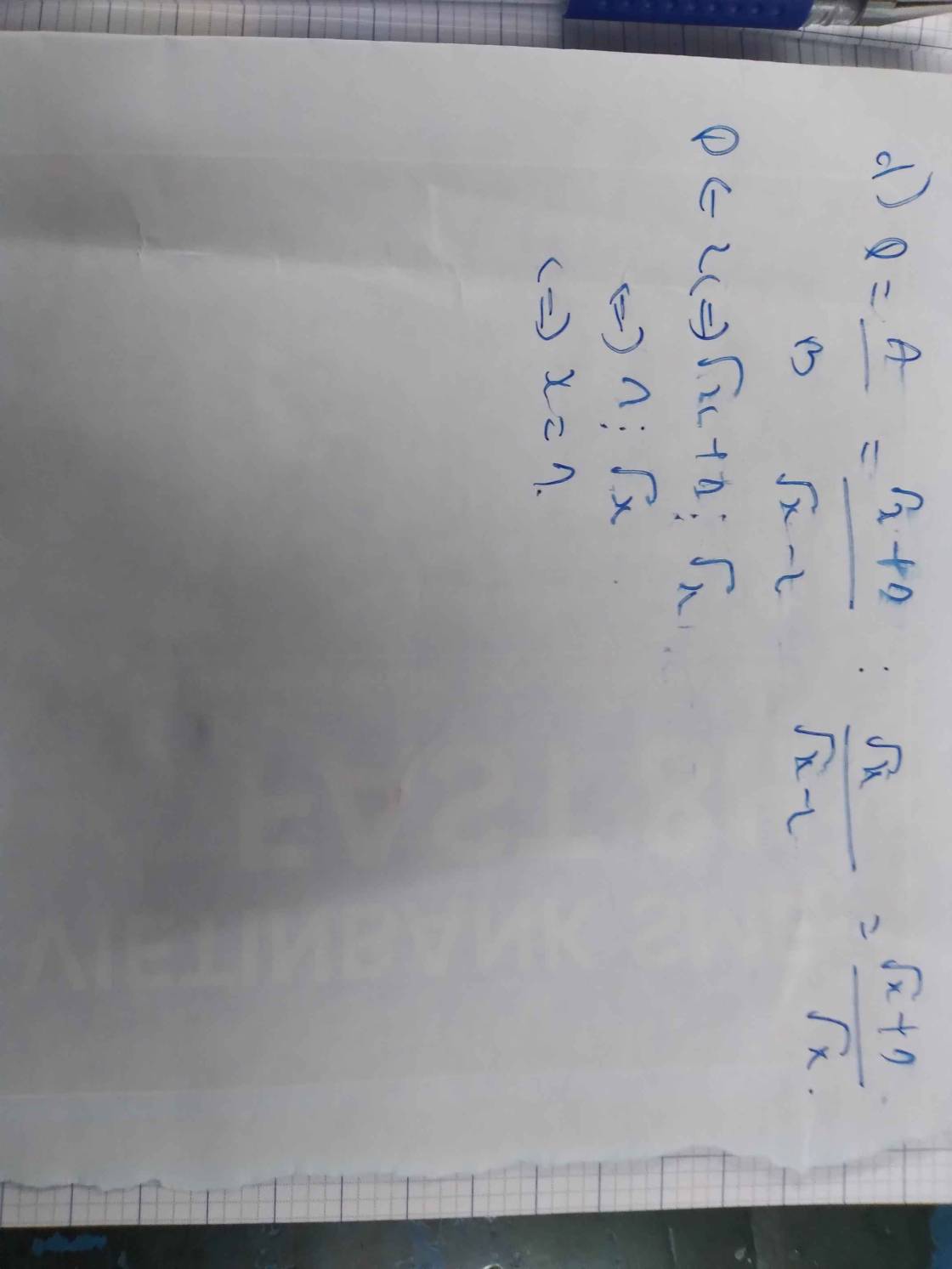Cho biểu thức A= \(\dfrac{2+\sqrt{x}}{\sqrt{x}}\), B= \(\dfrac{\sqrt{x}-1}{\sqrt{x}}+\dfrac{2\sqrt{x}+1}{x+\sqrt{x}}\) a) Tính giá trị của biểu thức A khi x=64 . b) Rút gọn B . c) Tính x để \(\dfrac{A}{B}>\dfrac{3}{2}\)Mong mọi người giúp em ạ . Cám ơn
Hãy nhập câu hỏi của bạn vào đây, nếu là tài khoản VIP, bạn sẽ được ưu tiên trả lời.


1: Khi x=64 thì \(A=\dfrac{8+2}{8}=\dfrac{10}{8}=\dfrac{5}{4}\)
2: \(B=\dfrac{\left(\sqrt{x}-1\right)\left(\sqrt{x}+1\right)+2\sqrt{x}+1}{\sqrt{x}\left(\sqrt{x}+1\right)}\)
\(=\dfrac{x-1+2\sqrt{x}+1}{\sqrt{x}\left(\sqrt{x}+1\right)}=\dfrac{\sqrt{x}\left(\sqrt{x}+2\right)}{\sqrt{x}\left(\sqrt{x}+1\right)}\)
\(=\dfrac{\sqrt{x}+2}{\sqrt{x}+1}\)
3: A/B>3/2
=>\(\dfrac{\sqrt{x}+2}{\sqrt{x}}:\dfrac{\sqrt{x}+2}{\sqrt{x}+1}-\dfrac{3}{2}>0\)
=>\(\dfrac{\sqrt{x}+1}{\sqrt{x}}-\dfrac{3}{2}>0\)
=>\(\dfrac{2\sqrt{x}+2-3\sqrt{x}}{\sqrt{x}\cdot2}>0\)
=>\(-\sqrt{x}+2>0\)
=>-căn x>-2
=>căn x<2
=>0<x<4
1) Thay x=64 vào A ta có:
\(A=\dfrac{2+\sqrt{64}}{\sqrt{64}}=\dfrac{2+8}{8}=\dfrac{5}{4}\)
2) \(B=\dfrac{\sqrt{x}-1}{\sqrt{x}}+\dfrac{2\sqrt{x}+1}{x+\sqrt{x}}\)
\(B=\dfrac{\left(\sqrt{x}-1\right)\left(\sqrt{x}+1\right)}{\sqrt{x}\left(\sqrt{x}+1\right)}+\dfrac{2\sqrt{x}+1}{\sqrt{x}\left(\sqrt{x}+1\right)}\)
\(B=\dfrac{x-1}{\sqrt{x}\left(\sqrt{x}+1\right)}+\dfrac{2\sqrt{x}+1}{\sqrt{x}\left(\sqrt{x}+1\right)}\)
\(B=\dfrac{x-1+2\sqrt{x}+1}{\sqrt{x}\left(\sqrt{x}+1\right)}\)
\(B=\dfrac{x+2\sqrt{x}}{\sqrt{x}\left(\sqrt{x}+1\right)}\)
\(B=\dfrac{\sqrt{x}\left(\sqrt{x}+2\right)}{\sqrt{x}\left(\sqrt{x}+1\right)}\)
\(B=\dfrac{\sqrt{x}+2}{\sqrt{x}+1}\)
3) Ta có:
\(\dfrac{A}{B}>\dfrac{3}{2}\) khi
\(\dfrac{\sqrt{x}+2}{\sqrt{x}}:\dfrac{\sqrt{x}+2}{\sqrt{x}+1}>\dfrac{3}{2}\)
\(\Leftrightarrow\dfrac{\sqrt{x}+2}{\sqrt{x}}\cdot\dfrac{\sqrt{x}+1}{\sqrt{x}+2}>\dfrac{3}{2}\)
\(\Leftrightarrow\dfrac{\sqrt{x}+1}{\sqrt{x}}>\dfrac{3}{2}\)
\(\Leftrightarrow\dfrac{\sqrt{x}+1}{\sqrt{x}}-\dfrac{3}{2}>0\)
\(\Leftrightarrow\dfrac{2\sqrt{x}+2-3\sqrt{x}}{2\sqrt{x}}>0\)
\(\Leftrightarrow\dfrac{2-\sqrt{x}}{2\sqrt{x}}>0\)
Mà: \(2\sqrt{x}\ge0\forall x\)
\(\Leftrightarrow2-\sqrt{x}>0\)
\(\Leftrightarrow\sqrt{x}< 2\)
\(\Leftrightarrow x< 4\)
Kết hợp với đk:
\(0< x< 4\)

a: Thay x=36 vào B, ta được:
\(B=\dfrac{6}{6-3}=\dfrac{6}{3}=2\)

Tiếp bạn Thịnh
1c)
Ta có:
\(S=A\cdot B=\dfrac{\sqrt{x}+1}{\sqrt{x}+2}\cdot\dfrac{\sqrt{x}+3}{\sqrt{x}+2}=\dfrac{\sqrt{x}+3}{\sqrt{x}+2}=1+\dfrac{1}{\sqrt{x}+2}\)
Mà \(\sqrt{x}\ge0\Rightarrow S\le1+\dfrac{1}{1+2}=1+\dfrac{1}{3}=\dfrac{4}{3}\)
Dấu "=" xảy ra khi x=0
Câu 2:
a) Để hưởng ứng phong trào phòng chống dịch COVID-19, một chi đoàn thanh niên dự định làm 600 chiếc mũ ngăn giọt bắn trong một thời gian quy định. Nhờ tăng năng suất lao động mỗi giờ chi đoàn đó làm được nhiều hơn so với kế hoạch là 30 chiếc nên công việc được hoàn thành sớm hơn quy định 1 giờ. Hỏi theo kế hoạch 1 giờ chi đoàn đó phải làm bao nhiêu chiếc mũ ngăn giọt bắn?
Giải : Gọi số chiếc mũ làm 1 h theo dự định là x (x là số tự nhiên khác 0 )
Vì có tất cả 600 chiếc nên làm trong 600/x giờ
Vì mỗi giờ chi đoàn đó làm được nhiều hơn so với kế hoạch là 30 chiếc (x+30 chiếc) nên công việc được hoàn thành trong 600/30+x.
Vì làm sớm hơn 1 h nên ta có phương trình:
600/x = 600/(30+x)+1
<=> 600(x+30)= 600x + (x+30)x
<=> x^2+30x - 18000=0
<=> (x-120)(x+150)=0
<=> x=120 (thỏa mãn x là số tự nhiên khác 0)

\(a,B=\dfrac{\left(\sqrt{x}+1\right)\left(x-\sqrt{x}+1\right)}{1+\sqrt{x}}-\sqrt{x}\\ B=x-\sqrt{x}+1-\sqrt{x}=\left(\sqrt{x}-1\right)^2\)
Mà \(x=4-2\sqrt{3}=\left(\sqrt{3}-1\right)^2\)
\(\Rightarrow B=\left(\sqrt{3}-1-1\right)^2=\left(\sqrt{3}-2\right)^2=7-4\sqrt{3}\)
\(b,P=AB=\dfrac{2x+1-x+\sqrt{x}}{\left(\sqrt{x}-1\right)\left(x+\sqrt{x}+1\right)}\cdot\left(\sqrt{x}-1\right)^2\\ P=\dfrac{\left(x+\sqrt{x}+1\right)\left(\sqrt{x}-1\right)}{x+\sqrt{x}+1}=\sqrt{x}-1\\ c,Q=\sqrt{x}+\dfrac{1}{P}=\sqrt{x}+\dfrac{1}{\sqrt{x}-1}\\ Q=\sqrt{x}-1+\dfrac{1}{\sqrt{x}-1}+1\ge2\sqrt{1}+1=3\\ Q_{min}=3\Leftrightarrow\left(\sqrt{x}-1\right)^2=1\Leftrightarrow\left[{}\begin{matrix}\sqrt{x}-1=1\\1-\sqrt{x}=1\end{matrix}\right.\Leftrightarrow\sqrt{x}=2\left(x>1\Leftrightarrow\right)x=4\left(tm\right)\)
a: \(B=\left(\sqrt{x}-1\right)^2=\left(\sqrt{3}-2\right)^2=7-4\sqrt{3}\)
b: \(A=\dfrac{2x+1-x+\sqrt{x}}{x\sqrt{x}-1}\cdot\left(\sqrt{x}-1\right)^2=\sqrt{x}-1\)

a) \(ĐKXĐ:\left\{{}\begin{matrix}x>0\\x\ne1\\x\ne4\end{matrix}\right.\)
\(\Leftrightarrow B=\dfrac{\sqrt{x}-\sqrt{x}-1}{\sqrt{x}\left(\sqrt{x}-1\right)}:\dfrac{x-1-x+4}{\left(\sqrt{x}-2\right)\left(\sqrt{x}+1\right)}\)
\(\Leftrightarrow B=\dfrac{-1}{\sqrt{x}\left(\sqrt{x}-1\right)}\cdot\dfrac{\left(\sqrt{x}-2\right)\left(\sqrt{x}-1\right)}{3}\)
\(\Leftrightarrow B=\dfrac{2-\sqrt{x}}{3\sqrt{x}}\)
b) \(x=4+2\sqrt{3}=\left(\sqrt{3}+1\right)^2\Rightarrow\sqrt{x}=\sqrt{3}+1\) (*)
Thay (*) vào B , ta được : \(B=\dfrac{2-\sqrt{3}-1}{3\sqrt{3}+3}=\dfrac{-\sqrt{3}+1}{3\sqrt{3}+3}\)

1) Sửa đề: x=0,09
Thay x=0,09 vào A, ta được:
\(A=\dfrac{\sqrt{0.09}}{\sqrt{0.09}-1}=\dfrac{0.3}{0.3-1}=\dfrac{0.3}{-0.7}=\dfrac{-3}{7}\)

a: Khi x=25 thì \(A=\dfrac{5-2}{5-1}=\dfrac{3}{4}\)
b: \(B=\dfrac{\sqrt{x}}{\sqrt{x}+1}-\dfrac{\sqrt{x}-4}{1-x}\)
\(=\dfrac{\sqrt{x}}{\sqrt{x}+1}+\dfrac{\sqrt{x}-4}{\left(\sqrt{x}-1\right)\left(\sqrt{x}+1\right)}\)
\(=\dfrac{\sqrt{x}\left(\sqrt{x}-1\right)+\sqrt{x}-4}{\left(\sqrt{x}-1\right)\left(\sqrt{x}+1\right)}\)
\(=\dfrac{x-\sqrt{x}+\sqrt{x}-4}{x-1}=\dfrac{x-4}{x-1}\)
c: \(P=\dfrac{A}{B}=\dfrac{\sqrt{x}-2}{\sqrt{x}-1}:\dfrac{\left(\sqrt{x}-2\right)\left(\sqrt{x}+2\right)}{\left(\sqrt{x}-1\right)\left(\sqrt{x}+1\right)}\)
\(=\dfrac{\sqrt{x}-2}{\sqrt{x}-1}\cdot\dfrac{\left(\sqrt{x}-1\right)\left(\sqrt{x}+1\right)}{\left(\sqrt{x}-2\right)\left(\sqrt{x}+2\right)}=\dfrac{\sqrt{x}+1}{\sqrt{x}+2}\)
P<1/2
=>P-1/2<0
=>\(\dfrac{\sqrt{x}+1}{\sqrt{x}+2}-\dfrac{1}{2}< 0\)
=>\(\dfrac{2\sqrt{x}+2-\sqrt{x}-2}{2\left(\sqrt{x}+2\right)}< 0\)
=>\(\dfrac{\sqrt{x}}{2\left(\sqrt{x}+2\right)}< 0\)
=>\(x\in\varnothing\)

a) ĐKXĐ: \(\left\{{}\begin{matrix}x\ge0\\x\ne1\end{matrix}\right.\)
b) Thay x=0 vào A, ta được:
\(A=\dfrac{15\cdot\sqrt{0}-11}{0+2\sqrt{0}-3}-\dfrac{3\sqrt{0}-2}{\sqrt{0}-1}-\dfrac{2\sqrt{0}+3}{\sqrt{0}+3}\)
\(=\dfrac{-11}{-3}-\dfrac{-2}{-1}-\dfrac{3}{3}\)
\(=\dfrac{11}{3}-2-1\)
\(=\dfrac{11}{3}-\dfrac{9}{3}=\dfrac{2}{3}\)



ĐKXĐ :x\(\ge\)0
a) với x=64 thỏa mãn đk; khi đó: A=\(\dfrac{2+\sqrt{64}}{\sqrt{64}}=\dfrac{2+8}{8}=\dfrac{5}{4}\)
b)với đk của x thì B xác định ; ta có
B\(=\dfrac{\left(\sqrt{x}-1\right)\left(\sqrt{x}+1\right)+\left(2\sqrt{x}+1\right)}{\sqrt{x}\left(\sqrt{x}+1\right)}\)\(=\dfrac{x+2\sqrt{x}+1}{\sqrt{x}\left(\sqrt{x}+1\right)}=\dfrac{\left(\sqrt{x}+1\right)^2}{\sqrt{x}\left(\sqrt{x}+1\right)}=\dfrac{\sqrt{x}+1}{\sqrt{x}}\)
c)Xét M=A:B =\(\dfrac{2+\sqrt{x}}{\sqrt{2}}:\dfrac{\sqrt{x}+1}{\sqrt{x}}=\dfrac{\sqrt{x}+2}{\sqrt{x}+1}\)
Để \(M>\dfrac{3}{2}hay\dfrac{\sqrt{x}+2}{\sqrt{x}+1}>\dfrac{3}{2}\Leftrightarrow2\sqrt{x}+4>3\sqrt{x}+3\left(do:\sqrt{x}+1>0\right)\Leftrightarrow\sqrt{x}< 1\Rightarrow x< 1\)
Kết hợp đk x\(\ge\)0. Vậy 0\(\le\)x<1 thì M=A:B>3/2